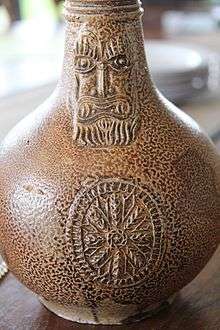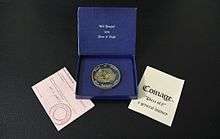Vergulde Draeck
The Vergulde Draeck (pronounced [vɛrˈɣɵldə ˈdraːk]), also spelled Vergulde Draak and Vergulde Draek, was a 41.8-metre (137 ft), 260-tonne (290-ton) ship constructed in 1653 by the Dutch East India Company (Dutch: Vereenigde Oostindische Compagnie, commonly abbreviated to VOC).[1][2]
The wrecking of the Vergulde Draeck
In 1656, the Vergulde Draeck set sail from the Cape of Good Hope, South Africa, for the VOC's trading headquarters at Batavia (Jakarta), Indonesia.[3][4]
On the night of the 28 April 1656, the Vergulde Draeck struck a submerged coral reef midway between what are now the coastal towns of Seabird and Ledge Point, Western Australia. On board were 193 crew, eight boxes of silver coins worth 78,600 guilders and trade goods to the value of 106,400 guilders.[3][4][5]
Of the 193 crew, 118 are believed to have perished. The initial 75 survivors, including the ship's captain Pieter Albertszoon, and the under steersman, made it to shore. They had with them the ship's boat, a schuyt, along with a small amount of provisions and stores washed on shore.[3][4]
Arrival in Batavia
On 7 May 1656, approximately nine days after the loss of the Vergulde Draeck, the under steersman and six crew members were dispatched to Batavia to summon help. They carried with them letters written by the crew which described the loss of the schuyt, the crew's decision to await rescue from Batavia, and their steadfast faith in the Lord God.
After a journey of some 1,400 nautical miles (2,600 km; 1,600 mi), lasting 41 days, with little water, little food and suffering from exposure, they arrived at Batavia. The alarm was raised and the search for the survivors of the Vergulde Draeck and cargo began.[6][5]
Rescue attempts
A number of rescue attempts was conducted by the Dutch East India Company once the loss was reported.[6]

The Goede Hope and the Witte Valck (1656)[3][6]
On 7 June 1656, two rescue vessels, the Goede Hoop and the Witte Valck, were dispatched from Batavia. Large storms off the West Australian coast meant that both ships were unsuccessful.
The Witte Valck failed to land men on the coast.
On 18 July 1656, the Goede Hoop managed to disembark men upon the shoreline; however, they lost three men along the coast who had wandered into the bush, before losing another eight men who went in search of them.
No sign of the survivors or wreckage was found.
The Vinck (1657)[3][4][6]
On 23 April 1657, the Vinck in the process of setting sail from the Cape of Good Hope was instructed to search for the survivors on its passage to Batavia.
No sign of the survivors or wreckage was found.
The Waeckende Boey & the Emeloordt (1658)[3][6]
On 1 January 1658, the Waeckende Boey and the Emeloordt were dispatched from Batavia. This time the rescue attempt was made in the more favourable summer months.
On 23 February 1658, Captain Volkersen of the Waeckende Boey sighted the Western Australian coastline, perhaps being the first European to sight what is today Rottnest Island, though it is possible Houtman may have sighted it in 1619.

On 26 February 1658, a shore party from the Waeckende Boey returning from the coast recorded the discovery of wreckage believed to be of the Vergulde Draeck. Most notable was a plank circle, a collection of some 12 to 13 planks placed in a circular fashion, dug into the beach sand with their ends facing skyward.
During the various searches, a small shore party from the Waeckende Boey led by Abraham Leeman became separated. Bad weather prevented Leeman from returning to the Waeckende Boey and after four days Leeman and his party were assumed lost. The modern town of Leeman, Western Australia is named after this Dutch explorer.
On 9 March 1658, Captain Jonck of the Emeloordt managed to send a small party to land. Upon returning, the shore party reported having seen three Aboriginal natives of tall stature who attempted to communicate with them using basic hand signals. This story of 'first contact' was a peaceful exchange, likely with the Yuet people of Western Australia.
Discovery of the Vergulde Draeck
The identity of the official discoverers of the Vergulde Draeck has been a contentious issue over many years though it is generally accepted that the wreck was found by John Cowen; Jim, Alan and Graeme Henderson; and Alan Robinson. An alternative claim was made by Robinson in his In Australia Treasure is not for the Finder.[7]
Letters written by the survivors of the Vergulde Draeck
In March 2015, Steve Caffery, of Gilt Dragon Research Group, claimed to have discovered copies of two letters carried by the seven survivors to Batavia in 1656. The letters, dated 5 and 7 May 1656, were said to indicate there were two separate camp sites.[8]
References
- "Vergulde Draak (1653)". De VOCsite (in Dutch). 2020. Retrieved 28 February 2020.
- "The Dutch East India Company's shipping between the Netherlands and Asia 1595-1795". huygens.knaw.nl. Huygens ING. Retrieved 1 February 2020.
- Henderson, James (1982). Marooned: the wreck of the Vergulde Draeck and the Abandonment and Escape from the Southland of Abraham Leeman in 1658. Perth: St. George Books. ISBN 0-86778-018-5.
- Green, Jeremy N. (1977). "The Loss of the Verenigde Oostindische Compagnie Jacht 'Vergulde Draeck', Western Australia 1656: An historical background and excavation report with an appendix on similar loss of the fluit 'Lastdrager'". BAR Supplementary Series. Oxford: British Archaeological Reports (36). ISBN 9780904531978. ISSN 0143-3016. OCLC 4388980.
- "Vergulde Draeck (Gilt Dragon)". The Maritime Archaeology shipwreck database. Western Australian Museum. 19 November 2012. Retrieved 21 July 2018.
- "Gilt Dragon History". Gilt Dragon Research Group. Retrieved 1 January 2019.
- Robinson, Alan (1980). In Australia Treasure is not for the Finder. Perth, Western Australia: Vanguard Service Print. ISBN 0-9594957-0-3.
- Jarvis, Lucy (31 March 2015). "Chasing the Dragon". North Coast Times. Retrieved 1 January 2019.
Further reading
- Robinson, A. (1980). In Australia Treasure is not for the Finder. Perth. Vanguard Service Print. ISBN 0-9594957-0-3
- Gerritsen, R. (1994). And Their Ghosts May Be Heard. Perth. Lamb Print. ISBN 1-86368-063-2
- Van Zanden, H. (2012). The Lost White Tribes of Australia 1656 Part One: The First Settlement of Australia. Australia. The Publishing Queen. ISBN 978-1-921673-67-2
- Major, H. R. (1859). Early Voyages to Terra Australis, Now Called Australia. London: Hakluyt Society.
- Henderson, James A. (1982). Marooned: the wreck of the Vergulde Draeck and the Abandonment and Escape from the Southland of Abraham Leeman in 1658. Perth, WA: St. George Books. ISBN 0-86778-018-5.
External links
| Wikimedia Commons has media related to Vergulde Draeck. |